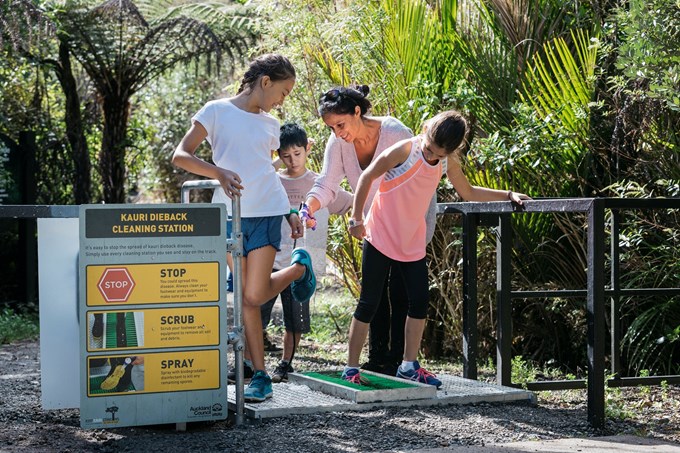Summer is here and so are our kauri ambassadors, who will be out and about in parks and on open tracks for the next few months.
Each ambassador is trained to share knowledge and answer questions about how to keep kauri safe – including how to use hygiene station to scrub and spray your footwear when you’re starting or finishing on a track.
Kauri Dieback Biosecurity Manager Lisa Tolich says ambassadors may come up to you for a chat while you’re at one of our parks – if they do, make sure to say hello and have a listen to what they have to say.
“Our ambassadors play a vital role in keeping Aucklanders and visitors to our parks informed about kauri dieback disease,” she says.
“These are people like you and me who are passionate about our city and have taken on this work because they believe in caring for our kauri.”
Samantha Carruthers, a second-time ambassador working in the northern region, says doing this job is a double win -she gets to spend her summer immersed in nature while also getting to play a part in looking after what she loves.
“We ambassadors work really hard to help protect forests that all of us want to enjoy,” she says.
“It’s a privilege to have so many kauri not far from my backdoor step and I take seriously the responsibility that we all have to keep them standing.”
The pathogen responsible for causing kauri dieback disease lives in soil, and can easily hitch a ride between tracks and forests via clumps of mud stuck to shoes and tyre treads. Tolich says this is why it’s so important to scrub, spray and stay.
The ambassador programme, which is running for the third year, opened last week with Auckland Council, Waitākere iwi Te Kawarau ā Maki and the Department of Conservation coming together for a full day training at Arataki Visitor Centre.

At a glance:
- More than 20 ambassadors across 14 regional and local parks
- Out on tracks from December to February
- Supported through the National Environment Targeted Rate
Kauri dieback – what you need to know:
What causes kauri dieback?
Kauri dieback is caused by a fungus-like pathogen called Phytophthora agathidicida, which was identified in 2008, and was formally known as Phytophthora taxon Agathis (or PTA).
How does kauri dieback kill kauri?
The microscopic Phytophthora agathidicida spores in the soil seek out and infect kauri roots, and then damage the tissues that carry nutrients within the tree. Infected trees will eventually show a range of symptoms, including yellowing foliage, leaf loss, dead branches, and often (but not always) lesions that bleed resin at the base of the trunk.
How is kauri dieback spread?
Any movement of contaminated soil can spread the disease, regardless of whether that soil came from around kauri trees or not. Human activity is a key cause of infected soil movement (on footwear and equipment). But the pathogen can also be moved by animals such as pigs, by water moving through the soil, and possibly by river and stream water.


